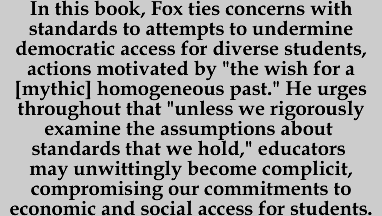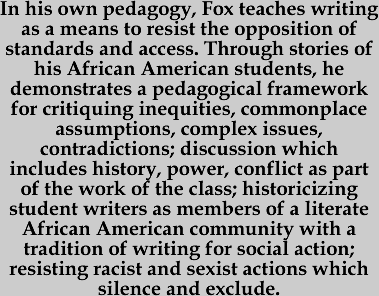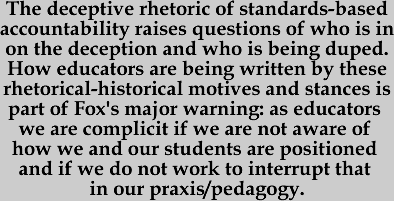|

Undoing the Tidy Tale
of Accountability - A Review
of Tom Fox’s Defending
Access: A Critique of Standards
in Higher Education
Suzanne M. Miller
1.1 In Defending access: A critique of standards in higher education, Tom
Fox argues that "standards” for writing work against the democratic purposes
for colleges. Through detailed historical, rhetorical, and empirical
critiques in five chapters, he demonstrates the key link of such "standards"
to subversion of access to college for students of color and other under-represented
groups. In his analysis, Fox helps to connect the dots to provide a bigger picture of what is going on in the
pervasive "standards" movement.
connect the dots to provide a bigger picture of what is going on in the
pervasive "standards" movement.
Standards as a Means
of Exclusion
2.1 For openers, Fox examines the conservative backlash that emerged when
diverse students began attending college during the second half of the
twentieth century. William Bennett’s claim that "standards were swept
aside," (1992, p. 156) illustrates the use of the word "standards"
as an odd singular-plural which suggests a have-or-have-not quality--"like
morals or values." (p. 3). This rhetorical push towards standardization
appears also in D’Souza’s lectures on merit, where Fox sees the individualist
"web of values that inhibits collectivity" (p. 5). These now-familiar
reactive notions are ahistorical and individualistic. What deeply disturbs
Fox, though, is how shrewd rhetorical strategies hide the real target:
"Their critique of falling or abandoned standards is always accompanied
by a critique of affirmative action and multiculturalism” (p. 5). In this
book, Fox ties concerns with standards to attempts to undermine democratic
access for diverse students, actions motivated by "the wish for a [mythic]
homogeneous past." He urges throughout that "unless we rigorously
examine the assumptions about standards that we hold" (p. 3), educators
may unwittingly become complicit, compromising our commitments to economic
and social access for students.
2.2
Fox elaborates the historical and social uses of standards "as a
means of exclusion" (p. 18) in the "troubled history" of the
development of college composition, alongside the history of meanings
that literacy held for African Americans. As Harvard introduced remedial
composition as a means of socializing non-elite students into "good
academic manners" (Miller, 1991, p. 66), those marked as needy were immigrants,
Jews, working classes. These standards were touted as a necessary means
of nationalistic unity. In a separate, parallel history of African American
writing Fox shows literacy which began as purposeful, collective political
practice—even emancipation—diverted towards domesticating literacy, through
acculturation into abstract institutional standards, to the "academic
manners of the elite" (p. 39). In both histories, he argues, literacy was undermined by elevating standards
of style, individual character, and morality.
2.3 In the early 1970s these two histories met in the Open Admission movement
in the City University of New York. Many new students of color went to
college, and fears of this change again elevated "standards"
to work against "ethnic integration" (p. 42). Fox’s analysis
of the rhetoric of that time in Chapter 3 exposes the connection between
standards of literacy and what appears to be morality, even cleanliness.
Students of color with their "problems" of verb endings, for example,
were portrayed as weak in the English language. In this social-political
context the "basic writer" was born, overdetermining and underestimating
the literacy of students of color and working class, non-native speakers,
Native Americans, and Chicanos. These different folk were contained in
a marginalized space of basic writing classes where literacy was reduced
to a set of skills apart from intention, meaning, action.
2.4 In the remainder of the book, Fox unpacks the tensions between democratic
access and exclusion through standards--in several ways. He puts a human
face on students disserved in these institutional spaces by closely looking
at the experiences and writing of Monica, Leon and many others, to demonstrate
the inadequacy of theories that look merely at language skills  and mechanics, or cultural styles. For instance, he examines the successful
academic work done by Leon’s exploration of his own oppositional identity
as he reflects critically on the complex topic of the conflicted racial
discourses he lives. Mechanical errors aside, Leon’s text is more
sophisticated than the simplistically unified texts that a decontextualized basic writing skills
pedagogy promotes (the topic sentence with details that fit the single
controlling idea). Leon's essay tackles his messy reality with academic
power. Yet the gatekeeping function of basic writing standards could exclude
Leon based on its limited, tidy version of academic literacy. and mechanics, or cultural styles. For instance, he examines the successful
academic work done by Leon’s exploration of his own oppositional identity
as he reflects critically on the complex topic of the conflicted racial
discourses he lives. Mechanical errors aside, Leon’s text is more
sophisticated than the simplistically unified texts that a decontextualized basic writing skills
pedagogy promotes (the topic sentence with details that fit the single
controlling idea). Leon's essay tackles his messy reality with academic
power. Yet the gatekeeping function of basic writing standards could exclude
Leon based on its limited, tidy version of academic literacy.
2.5
To illustrate coordinated action for working against ideologies which exclude
students of color, Fox provides a collective case study of three writing
programs at his own university. He argues the need to avoid complicity
with dominant ideologies by examining rigorously the assumptions embedded
in local rhetoric about standards, in order to use leadership positions
for resistive practices. While such work is local and cannot fix all oppressive
structures and racist exclusions, Fox shows how rhetorical vigilance against
ideologies which limit access can over time offer opportunities to recast
agendas, provide forums, and subtly transform institutions.
2.6 In his own pedagogy, Fox teaches writing as a means to resist the opposition
of standards and access. Through stories of his African American students,
he demonstrates a pedagogical framework for critiquing inequities, commonplace
assumptions, complex issues, contradictions; discussion which includes
history, power, conflict as part of the work of the class; historicizing
student writers as members of a literate African American community with
a tradition of writing for social action; resisting racist and sexist
actions which silence and exclude. Moving away from notions of "mysterious
ailments" in their language to social action in their writing, his
students begin to reconceive academic prose as potentially liberatory
and powerful. In the end, Fox recommends that teachers construct
such transformative pedagogies, stick around to show students how to grapple
with cultural difference and racism to create standards for access--and
then let students show the way.
Relevance for the K-12
Standards Movement
3.1 Although Fox focuses his critique of standards on higher education, much
of his argument is quite relevant to the standards movement in K-12 education.
Concerns about minority access to college could well begin years before
the freshman year—in elementary and grade school where hopes for higher
education are shaped or dashed.
Standards creating domesticating
literacy
3.2 In particular, the reduction of literacy to narrowly defined writing standards
in higher-education mirrors what is happening in the public schools.
For example, in an interview study of almost 400 teachers in 5 states
and analysis of state standards and the writing tests derived from them,
Hillocks (2002) concludes that state writing tests have a generally harmful
effect on the way students are taught to write. The investment of millions
of dollars and hundreds of thousands of hours of teacher and student time
for standards-based assessments of writing, he finds, encourages teachers
to focus on simplistic structures for writing (what goes where) rather
than on strategies of inquiry for thinking through problems (p.
201). Although in state rhetoric the goals are "raising standards"
and "achieving excellence," Hillocks carefully documents that
the standards underlying state writing tests do not represent excellence
and that tests derived from them do not detect excellence.
3.3 A longitudinal study of New York English
teachers' response to the standards-based writing assessment (Miller,
2002, 2003) provides evidence that over time in many schools, test-prep
practice developed into a kind of rote writing, a paint-by-numbers composing
with such explicit patterning that students would have "no questions."
Student thinking about the topic in a timed test on an unfamiliar topic
(e.g., medieval cooking or Suzuki violin) was construed as a disadvantage.
In one teacher's critique, the writing test in his working class school
seemed like "[a] dog show —with students trained to do specific tasks fast." Developing writing
skills which can be produced for evaluation of information-processing
often under timed circumstances narrows the curriculum toward a "domesticating"
rather than "empowering" literacy —passivity rather than critical thinking (Anyon, 1997; Finn,1999).
The resulting texts are simplistically unified, like the ones Fox says
are promoted in basic writing. Long before college, many students trained
to meet state standards for tests are denied access to rich literacy.
Learning to think through complex issues in talking and writing in K-12,
Hillocks (2002) argues, "appears to be confined to an elite group" (p.
7).
Minority students losing access
in the new discrimination
3.4 Despite eloquent arguments against "one-shot, timed, writing tests"
the "ideas of acontextual standards as fair, equal, reasonable"
have become commonsense institutional notions—even though "these tests typically fail nonnative speakers of English—African
Americans, Latinos and other groups seeking access to higher education"
(Fox, p. 112).
3.5
Similarly in K-12 education, such centralized standards and testing of
writing create many losses for underrepresented minority students. New
inequalities for K-12 minority students are part of the "contradictions
of reform" (McNeil, 2000) rhetorically aimed at "excellence"
for all students. McNeil studied the widely emulated standards and accountability
system in Texas, the Texas Assessment of Academic Skills (TASS), which
is, in part, a test of writing. Her analysis reveals "the new discrimination"
in the standardized system with "the appearance of sameness to mask
persistent inequalities" (p. 731). Like Fox, McNeil creates
sensitive portraits of highly successful teaching and learning among students
of color—in urban magnet schools
where, for example, Latino students examine Gary Soto’s poetry and trace
initiation themes in Bless Me, Ultima. However, pervasive,
expensive test-prep books are displacing substantive curriculum, chiefly
in African American and Latino schools. These under-resourced schools
invest in test-prep books to raise test scores—the only means in this
accounting system of gaining more funding. The commercial TAAS test-prep
materials for writing provide exercises on five-paragraph essays and exercises
in mechanics (Hillocks, 2000). Thus, in this system, a cumulative deficit
grows "separating minority students from the education being provided
their more privileged peers" (McNeil, 2000).
3.6
As test scores rise in Texas, underrepresented minority children are dropping
out of school at increasing rates (Haney, 2000; McNeil, 2000). According
to Haney,
TAAS is having a continuing adverse
impact on Black and Hispanic students: Only 50% of minority students
in Texas have been progressing from grade 9 to high school graduation
since the initiation of the TAAS testing program. Since about 1982,
the rates at which Black and Hispanic students are required to repeat
grade 9 have climbed steadily, such that by the late 1990s, nearly 30%
of Black and Hispanic students were "failing" grade 9. Cumulative rates
of grade retention in Texas are almost twice as high for Black and Hispanic
students as for White students.
Rather than bringing equity and access,
McNeill argues, "Educational standardization harms teaching and learning
and, over the long term, restratifies education by race and class"
(McNeill, 2000, xxvii). Raising standards with no investment in equalizing
resources for historically underresourced urban schools, she argues, "is
no reform. It is a creative new form of discrimination." (p. 732).
Such inequity harms minority children, cutting short life chances long
before they have any chance of gaining access to college.
Undoing the tidy tale of accountability
K-16
3.7
Given this common ground, K-16 educators
working together might better uncover the hidden complexities in the tidy
tale of accountability told by the national and local standards movements.
Linking Tom Fox's critique of standards and access in higher education
to the current scene in the public schools allows a broader story through
which to unpack the historical-rhetorical motives of those who push for
educational standards.
3.8 Fox traces the historical and political underpinnings of the skills view
of writing, arguing that "Teaching basic skills underestimates and undermines
both teachers and students" (p. 53). Representing teaching
and learning as skills-based approaches narrows the purpose for teaching
English/writing, brings teaching and learning under control with assumptions
of neutral knowledge, pure motives, educators as technicians and a tidy
tale of accountability. This skills approach is evident in K-12 state
writing assessments which "control learning" and harm student
writing (Hillocks, 2002).
3.9
What K-16 students need, instead, are
opportunities for focused exploration of complex topics and critical reflection
on the multiple discourses in which they live (e.g, home, school, work,
media).
3.10 In historicizing basic writing, Fox shows how clever rhetoric masks discrimination.
Uncovering the rhetoric of "raising standards" and accountability—McNeil does the same for for K-12. In both analyses, the language of equity
hides the intentions and assumptions of inadequacy and deficit-theories.
3.11 The notion of using a single indicator of student performance for basic-writing
or school testing comes from "business-controlled management accountability
systems"—so that control is away from the profession and the public (McNeil, 2000)
and toward a status quo business-values system. This is the not-so-hidden
politics underlying the language of standards. Fox points to the
distortions of intention in the "misnamed California Civil Rights
Initiative" (p. 7) which ended affirmative-action programs for women
and people of color--in order to raise standards. The same distortion
is evident in the misnamed No Child Left Behind documents with rhetoric
"contrived specifically to place blame directly on the children,
their parents, and their teachers through this colonial model of education
while perpetuating the myth of a democratic model of education" (e.g.,
Wilson & Segal, 2003).
3.12 Clearly, the stated intention of basic writing in colleges was to provide
support for writers perceived as struggling, yet the resulting stratification
of classes marginalized those students and positioned them as deficient,
underestimating their literacy. The irony that the original rhetorical
intent of the K-12 standards movement--to provide a level playing field--may
be accomplishing just the opposite has been addressed by many researchers,
including McNeil (2000): "The apparent 'sameness' of the test masks
persistent disparities in the conditions of learning that children face"
(p. 732).
3.13 The genesis of standards for K-16 is the same political impulse
to standardize students and uses a logical-deductive argument whose rhetoric
hides its political agenda.
3.14 A
tidy tale of "accountability"—raising standards and
thereby assuring achievement for all—sanitizes the messy historicized
reality.
3.15
In each case, we need the human faces
of standards to interpret the usefulness of the logical-deductive argument.
Through the lived experiences of Leon and Samantha and the others, we
need to test the logical-rhetorical arguments. We should be troubled by
the historical uses of standards to limit access, and take on the local
work of unpacking the rhetoric and using theoretical tools to account
for it.
3.16 In focus groups teachers living the experiences in K-12 always turned
to discrepancies across their school districts (Miller, 2002, 2003). More
affluent districts provided more time and resources—even extra pay—for their teachers to score writing exams in a professional and reflective
manner. Urban teachers had none of that. An experienced urban teacher
in this conversation formulated her own version of test ideology as "fixing
the game…Keeping people in their place"—a vision of racist stratification
as the underlying motive for standards-based assessments. Besides the
issue of inequity, this African American teacher questioned the validity
of the test on several other grounds, particularly the damage it causes
by taking away from children and adding nothing:
It’s pulling from children, it doesn’t
add anything; it doesn’t assess their learning, it doesn’t show growth,
it’s certainly not showing any progress from one point to the next.
It’s pulling things out because testing means something to children….Children
think it tells you if you’re competent or not.
In this critique by a high school
teacher the school use of testing standards to assess deficits could be
seen as the prior-history of Leon--and Fox’s other students. The
historical-rhetorical motives and consequences are all of a piece for
college and K-12 contexts.
What way, teachers?
4.1 The deceptive rhetoric of standards-based accountability raises questions
of who is in on the deception and who is being duped. How educators are
being written by these rhetorical-historical motives and stances is part
of Fox’s major warning: as educators we are complicit if we are not aware
of how we and our students are positioned and if we do not work to interrupt
that in our praxis/pedagogy.
4.
2 Critiques of the standards movement suggest that investments in accountability
"serve a political function in centralizing control over education"
(McNeil, p. 732) and teachers in the system are rewarded for compliance,
as are students. Teachers feel their change of status from subjects to
objects of reform: they feel that they, like the students one teacher
in a working class school described, "are something to be worked
on rather than an agent for their own education" (Miller,
2002).
4.3 If the intent of the standards and accountability movement is shifting
control of public education away from the public and the profession, what
new roles might teachers play? Fox outlines the need for college faculty
to be active political workers, transformative intellectuals critiquing ideologies, engaging
in resistive practice. workers, transformative intellectuals critiquing ideologies, engaging
in resistive practice.
4.4
The K-12 teachers, like higher-ed
composition faculty, are vulnerable and caught in a system. Collective
action among some K-12 teachers has strengthened their ability to resist
test-prep teaching and promote powerful literacy by linking with like-minded
educators in email groups, book clubs, and professional organizations
(Miller, 2002).
4.5 What might collaboration across the K-12 and college boundaries look like?
What kinds of resistive practice might coordinated political action involve?
How might collective work on behalf of students help them "resist
the limiting and damaging practices" that deter access? Fox’s
framework for writing standards which work for access based on
teachers’ judgments may be a starting point for critical dialogue on continuities
for K-16 education. A few teachers working across these boundaries are
beginning to show the way (e.g., Appleman, 2000; Carey-Webb, 2001; Gaughin,
1997; Vinz, 2000).
4.6 Failing children, disenfranchising them, reifying unequal structures
of opportunity are, in a real sense, failures of democratic education
(Bomer, 2002). Critiquing the rhetoric of standards, grappling with cultural
difference, writing for social action, are, in a true sense, education
to transform.
References
Anyon, Jean (1997). Ghetto schooling.
Teachers College Press, Teachers College, Columbia University.
Appleman, D. (2000). Critical encounters in high school English: Teaching
literary theory to adolescents. Teachers College Press & NCTE.
Bennett, W. (1992). The devaluing of America:
The fight for our culture and our children. New York: Summit.
Bomer, R. (2001). Genres of action in the era of high-stakes testing.
Paper presented in the What’s really at stake here? Conference on English
Education (CEE) Colloquium at the Annual Conference of the National Council
of Teachers of English, Baltimore.
Carey-Webb, A. (2001). Literature and lives: A response-based, cultural
studies approach to teaching English. NCTE.
Finn, P. (1999) Literacy with an attitude:
Educating working-class children in their own self-interest. Albany:
State University of New York Press.
Gaughin, J. (1997). Cultural reflections: Critical teaching and learning
in the English classroom. Boynton Cook/Heinemann.
Haney, W. (2000). The myth of the Texas miracle in education. Education
Policy Analysis Archives, 8(41). Available at http://olam.ed.asu.edu/epaa/v8n41/part7.htm
Hillocks, G., Jr. (2002). The testing trap: How state writing assessments
control learning. New York: Teachers College Press.
McNeil, Linda M. (2000, June). Creating new inequalities: Contradictions
of reform. Phi Delta Kappan, pp. 729-734.
Miller,
S. (1991). Textual Carnivals. Carbondale, IL: Southern Illinois
University Press.
Miller, S.M. (2002). Reflective teaching the panic of high-stakes testing.
English Education, 34(2), pp. 164-168.
Miller, S. M., McMaster, R. Schroeder, S. (2003, April). Accountability
and/or Achievement? English teachers changing responses to high-stakes
testing. Paper presented at the Annual Conference of the American
Educational Research Association. Chicago.
Vinz, Ruth. (2000). Becoming (Other)wise: Enhancing critical reading
perspectives. Calendar Islands Publishers.
Wilson, A. & Segall, W. (2003, April). Glorification of Accountability
Through Federal Legislation: Dis-Locating Meanings With/In/Through the
No Child Left Behind Act. Paper presented at the Annual
Conference of the American Educational Research Association. Chicago.
|
![]()
 connect the dots to provide a bigger picture of what is going on in the
pervasive "standards" movement.
connect the dots to provide a bigger picture of what is going on in the
pervasive "standards" movement.  and mechanics, or cultural styles. For instance, he examines the successful
academic work done by Leon’s exploration of his own oppositional identity
as he reflects critically on the complex topic of the conflicted racial
discourses he lives. Mechanical errors aside, Leon’s text is more
sophisticated than the simplistically unified texts that a decontextualized basic writing skills
pedagogy promotes (the topic sentence with details that fit the single
controlling idea). Leon's essay tackles his messy reality with academic
power. Yet the gatekeeping function of basic writing standards could exclude
Leon based on its limited, tidy version of academic literacy.
and mechanics, or cultural styles. For instance, he examines the successful
academic work done by Leon’s exploration of his own oppositional identity
as he reflects critically on the complex topic of the conflicted racial
discourses he lives. Mechanical errors aside, Leon’s text is more
sophisticated than the simplistically unified texts that a decontextualized basic writing skills
pedagogy promotes (the topic sentence with details that fit the single
controlling idea). Leon's essay tackles his messy reality with academic
power. Yet the gatekeeping function of basic writing standards could exclude
Leon based on its limited, tidy version of academic literacy. workers, transformative intellectuals critiquing ideologies, engaging
in resistive practice.
workers, transformative intellectuals critiquing ideologies, engaging
in resistive practice. 